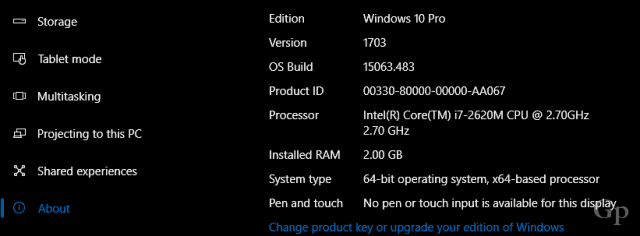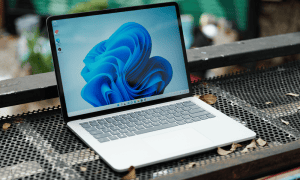It’s Official: Intel Atom Clover Trail PCs Can’t Upgrade to Windows 10 Creators Update

Older PCs won’t be able to enjoy the latest feature updates for Windows 10. Find out if you’re affected and how.
Microsoft confirmed this week that devices running Intel Clover Trail (Atom) processors would not be receiving support for Microsoft’s most recent release of Windows 10, called the Creators Update. Instead, Microsoft promises to support these older processors using the previous Windows 10 Anniversary Update release, version 1607. In addition, Microsoft promises to provide security updates until January 2023, which coincides with the end of the support schedule for Windows 8.
Certain Intel Atom Processors Will Not Support Future Revisions of Windows 10
So, what does this mean for you? Well, it means you won’t be able to run the Windows 10 Creators Update or the upcoming Fall Creators Update (1709). The good news is that the still solid Windows 10 Anniversary Update, launched in August of 2016, has many years left in it. The unfortunate part is that the ongoing refinements users look forward to in each Feature Update will be unavailable to these systems.
Microsoft provided a statement to the press explaining its decision to end support.
With Windows 10, we introduced Windows as a Service, a model for continuous value delivery via twice annual feature updates and monthly quality updates. Along with this updated delivery cadence, we adjusted our support lifecycle policies to reflect the Windows as a Service model. Recognizing that a combination of hardware, driver and firmware support is required to have a good Windows 10 experience, we updated our support lifecycle policy to align with the hardware support period for a given device. If a hardware partner stops supporting a given device or one of its key components and stops providing driver updates, firmware updates, or fixes, it may mean that device will not be able to properly run a future Windows 10 feature update.
This is the case with devices utilizing Intel Clover Trail Atom Processors1 today: they require additional hardware support to provide the best possible experience when updating to the latest Windows 10 feature update, the Windows 10 Creators Update. However, these systems are no longer supported by Intel (End of Interactive Support), and without the necessary driver support, they may be incapable of moving to the Windows 10 Creators Update without a potential performance impact.
We know issues like this exist and we actively work to identify the best support path for older hardware. As part of our commitment to customers, we will be offering the Windows 10 Anniversary Update to these Intel Clover Trail devices on Windows 10, which we know provides a good user experience. To keep our customers secure, we will provide security updates to these specific devices running the Windows 10 Anniversary Update until January of 2023, which aligns with the original Windows 8.1 extended support period. Source: Microsoft
To find out if your system is one of those affected, click Start > Settings > System > About and look at the processor information for details. In my case, I am running an Intel Core i7, so I have nothing to worry about. However, if yours says Intel Atom with the designations Z2760, Z2580, Z2560, or Z2520, you are unfortunately on the “no” list for future feature upgrades.


Summing Up
The Intel Atom was originally launched in 2008 and was specifically designed for what was known as the netbook form factor. Netbooks were all the rage back in the 2008 to 2011 years. It was to the point that Microsoft had to give its Windows XP operating system a reprieve to support the underpowered processors. As a result, the Windows 7 release, launched in 2009, was more optimized for the architecture.
Intel Atom survived the Windows 8 wave by embracing the new, cheap, 8-inch tablet form factors that flooded the market at the time. Ironically, these Intel processors’ same performance scenarios were designed for what’s prevented them from qualifying for future upgrades. This is a reality we have to accept going forward, and it’s not necessarily unique to Windows 10. Back in 2012, my Dell Dimension 8300, with its 3.2 GHz Intel Netburst met the minimum requirements, but it didn’t make a list because of specific security requirements at the processor level.
We are interested in hearing your thoughts about these changes. Will this force you to purchase a new Windows 10 ready device? If so, let us know in the comments.
14 Comments
Leave a Reply
Leave a Reply







R. LEECH
July 21, 2017 at 11:21 am
I got update10 and it is not compatible either. I had to reset my computer to wipe it clean after the
update. MS promises a fix or update next month. GOOD LUCK!
R. Leech
July 24, 2017 at 4:10 pm
I forgot to mention (because I was so mad) that I just bought a Dell Laptop manufacture date December 2016 with windows 10 installed.
Windows 10 Creator’s update destroyed my computer.
Constant crashes and BSOD
ramu kaviyoor
July 23, 2017 at 11:48 am
My ASUS K55VJ – 3rd gen i5, 2.5Ghz, 8 GB RAM – too had some hiccups after the Creators Update. Microsoft says the notebook is not compatible with Windows 10, but the specs for Windows 10 fits it.
The website of Asus too confirms that this is not for Win 10. They have not replied to my email.. The hardware was working well. It’s only certain procedures that caused the problem. Microsoft says it is a driver problem which I think is not true.
What Asus has done is unethical.
I am back to Win 8.1. Well, heads they win, tails I lose.
Stefan
October 20, 2017 at 2:56 pm
Not true, I have 1703 on my Toshiba tablet
techhead51
October 21, 2017 at 11:02 am
When win10 was forced onto so many devices, the term was for the life of the device, not when new hardware would emerge.
As intel and amd are fighting the cpu war, the opportunity to push new technologies equals nothing more than sales for MS, xbox, mixed reality etc.
So MS revised terms of service(s) is based on what intel and amd are pushing, nothing new.
My hp laptop can not upgrade not because of hp but because MS decided amd has new stuff, so go buy a new device.
Not for me, when the laptop does not get anymore updates, I will put steamos or another linux distro on it and this will be done on desktops.
I will purge all computing devices from the MS, not because the hardware can not run win10, but because MS has fallen back on their original promise.
Marcus Sheker
December 8, 2017 at 8:30 am
Back in December 2015, on the Microsoft home page, they had the 12-days-of-Christmas, and I purchased an “HP Pavilion x2 detachable PC 10”. Processor: Intel(R) Atom(TM) CPU Z3736F @ 1.33GHz; RAM: 2.0 GB; Windows Type: 32-bit OS. I try to get the latest windows 10 version, but it says, you already have the latest version, version 1607; OS build: 14393.1914. If I download the 1709 update, I get an error message, and it won’t install. (The tablet really isn’t that old, but I guess the processor they used is.)
So, I guess you can add Z3736F to your list of (Z2760, Z2580, Z2560, Z2520).
Tony
December 14, 2017 at 5:45 am
You can add the Atom 330 @ 1.60GHz to the list as well. This is just an HTPC that doesn’t need the extra functions in the fall update. If it’s nor compatible why continuously try to install the update via Windows Update?
Ilidio Martins
December 14, 2017 at 3:35 pm
I have a intel core i7 Q740 in my Sony CPU speed 1.73Ghz
OS- 64 bits, but this actualisation doesn’t work. It stop in midle of process and shut down the computer.
After that when I turn it on the system recover the previous version of win10.
Lorie
January 25, 2018 at 8:14 pm
i have intel core i7-3610QM on my HP Pavillion 64bit Windows 10 Home OS v1607. the 1703 and 1709 updates will not complete no matter how i try to update it, and the Windows Update Troubleshooter will not resolve the issue either.
Glenn Dawe
February 5, 2018 at 12:18 pm
Having recently moved back to my home PC from my work based MacBook, I find nothing but troubles now with the 1709 upgrade being forced down my throat! Version 1607 was working fine but since this latest update keeps trying to install unsuccessfully this PC has become nothing more than a boat anchor! Why can’t I be left with version 1607?
Having lost access to my work MacBook, it looks like I will have to go out and buy my own Mac to replace this antiquated Microsoft crap!
Phil O
March 19, 2018 at 3:10 am
Like several before have said MS keep pushing the update. I tried loading only to be told after nearly an hour that I had an incompatible processor- tough luck. As others have mentioned this is happening on reasonably new PCs, mine is a HP Envy only two years old. As usual MS couldn’t give a sh__!
Mergatroid
March 21, 2018 at 3:14 pm
I would be willing to bet that half the people complaining here could get a working installation of 1709 if they did a clean install.
Download Microsoft Media Creator and run it. Make media on either an 8GB USB Flash Drive or on a dual layer DVD (it must be dual layer or it will not have enough space).
Once this is done, back up everything you want to keep on external media including your documents, pictures and any other files. Note, if you have MS Office installed, you will need either A: Your installation media and key, or B: Your microsoft account information so you can re-download it and install it again. Don’t forget to back up your bookmarks in your browsers
Once done backing up, insert your DVD or USB thumb drive media and boot from it. When it gets to the screen saying do you want to upgrade or custom install, choose custom install. On the next screen when it asks you for a key, select “I don’t have a key” (it will activate Windows automatically based on your CPU serial number as long as you had Windows 10 installed previously). On the next screen, delete ALL partitions, and then create a new partition. When you click NEXT, Windows will create any further required partitions.
Let the installation continue until it’s done. Note, if your computer resets and stops at the screen asking you for your keyboard type and country, remove your boot media (DVD or flash drive), shut the computer off and turn it back on again. Check Device manager when the install is complete to see if you need any drivers. You can do Windows Updates to see if Windows will find the drivers for you. If it doesn’t, check the manufacturers website. If you are unsure, Google how to find missing drivers, or have a tech friend do it for you. Don’t use a driver updater program as half of them are riddled with malware.
Microsoft never promised they would support every piece of hardware indefinitely. However, I do understand people complaining about this update being pushed on them if it doesn’t work, and this is the exact reason why we should be able to stop these updates manually (specifically driver updates and “feature updates”). At least we can block driver updates.
If Microsoft buggers your computer, sue them in small claims court. They will pay you rather than have to pay lawyers.
Jane
March 24, 2018 at 6:41 am
“Certain Intel Atom Processors Will Not Support Future Revisions of Windows 10
So, what does this mean for you? Well, first it means we lied & screwed you by saying to update & now saying, “sux to be you!, you won’t be able to run the Windows 10 Creators Update or the upcoming Fall Creators Update (1709)”. However, the good/better news is that the still solid Windows 10 Anniversary Update, launched in August of 2016 has a lot of years left in it. The unfortunate part is that the ongoing refinements users look forward to in each Feature Update will be unavailable to these systems.”
In plain English: you’ll have a stable operating system and won’t have to go through the agony of your system being broken with every new, worthless bit of nonsense MS decides to “try out” on you. Congrats! xx Posted 24 Mar. 2018
Paul
April 21, 2018 at 7:47 pm
The bigger nuisance is that it tries to download the ‘update’ on a metered connection (which it claims it won’t do) for close to 1Gb then decide it can’t install. I really would prefer to be able to turn off updates – especially when I know they won’t go on. (Toshiba Encore 2 with 32Gb space total, 1Gb RAM)